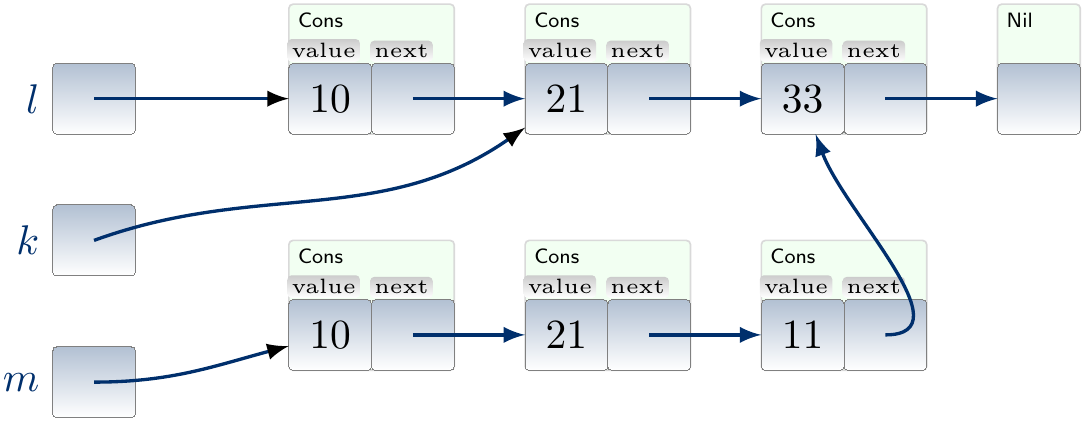Linked lists¶
Immutable linked lists¶
This is recap from the “Recursion” round of CS-A1120 Programming 2. Immutable linked lists are used in many functional programming languages to store and manipulate sequences of elements. Once created, the lists are not modified: if a list is, for instance, filtered with some predicate, then a new list representing the result is returned and the original list stays unmodified. In Scala, immutable lists are implemented in the class collection.immutable.List.
The idea was simply to have, for each element in the sequence,
a list entry object that stores
(i) the element, and
(ii) a reference to the entry of the next element in the sequence
(for the last element, the reference is either null or
the next entry is a special “Nil” entry having no element).
In the immutable case,
list entries can be shared between different lists.
Example
The figure below shows the object diagram
for an immutable linked list l of three integers.

Making a list k that is obtained from l by
removing the first element is easy:
k is simply the reference to the next entry of the first entry in l.

On the other hand,
building the list m obtained from l by adding 11 after 21
requires us to copy the prefix of the list into
a new sequence of entries:

Properties:
Constant-time element insertion and removal in the beginning of the list, provided that allocating the memore for the new list entry takes constant-time.
Random access, ie. finding the \( i \)th element, takes linear time.
Adding elements at the end takes linear time.
Mutable linked lists¶
One can also have a mutable version of linked lists. In such lists, the list entries are not shared between different lists. Furthermore, it is common to have a separate object for maintaining some addional information: (i) the reference the first entry in the list, (ii) the reference the last entry in the list, and (iii) the current list length. With such additional information, one can add and remove elements both in the beginning and at the end of the list in constant-time. Furthermore, finding out the size of the list is easy as well.
Example: Mutable linked lists
The object diagram of a mutable linked list of three integers:

The same list after adding the value 11 at the end:

A doubly-linked variant of mutable linked lists adds, to each entry, a reference pointing to the previous entry. Such list can be efficiently traversed in reverse order as well.
Given a pointer to a list entry anywhere in the list, removing it or adding an element before/after it is also easy due to the forward and backward references.
Example
The simple code below shows how a mutable linked list can be created and modified by using iterators in C++.
#include <iostream>
#include <list>
int main() {
std::list<int> l;
for(int i = 1; i <= 5; i++)
l.push_back(i);
std::cout << "Before:";
for(auto v: l) std::cout << " " << v;
std::cout << std::endl;
// Remove odd numbers and insert 2*v after each even v
for(auto it = l.begin(); it != l.end(); ) {
int v = *it;
if((v & 0x01) == 1) it = l.erase(it);
else l.insert(++it, 2*v);
}
std::cout << "After:";
for(auto v: l) std::cout << " " << v;
std::cout << std::endl;
return 0;
}
The output is
Before: 1 2 3 4 5
After: 2 4 4 8
Mutable linked lists in some standard libraries:
In Scala, ListBuffer implements singly-linked list.
In C++, list implements doubly-linked lists.
In Java, LinkedList implements doubly-linked lists.
